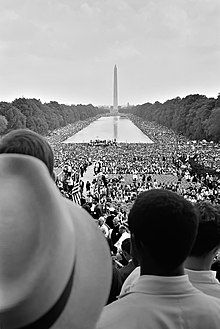
The civil rights movement was a social movement and campaign from 1954 to 1968 in the United States to abolish legalized racial segregation, discrimination, and disenfranchisement in the country. The movement had its origins in the Reconstruction era during the late 19th century and had its modern roots in the 1940s, although the movement made its largest legislative gains in the 1960s after years of direct actions and grassroots protests. The social movement's major nonviolent resistance and civil disobedience campaigns eventually secured new protections in federal law for the civil rights of all Americans.

The Southern Christian Leadership Conference (SCLC) is an African-American civil rights organization based in Atlanta, Georgia. SCLC is closely associated with its first president, Martin Luther King Jr., who had a large role in the American civil rights movement.
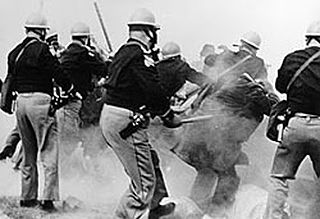
The Selma to Montgomery marches were three protest marches, held in 1965, along the 54-mile (87 km) highway from Selma, Alabama, to the state capital of Montgomery. The marches were organized by nonviolent activists to demonstrate the desire of African-American citizens to exercise their constitutional right to vote, in defiance of segregationist repression; they were part of a broader voting rights movement underway in Selma and throughout the American South. By highlighting racial injustice, they contributed to passage that year of the Voting Rights Act, a landmark federal achievement of the civil rights movement.
Charles Lee Moore was an American photographer known for his photographs documenting the Civil Rights Movement. Probably his most famous photo is of Martin Luther King Jr.'s arrest for loitering on September 3, 1958. It is this photo that sparked Moore's involvement in the Civil Rights Movement.

Daniel Budnik was an American photographer noted for his portraits of artists and photographs of the Civil Rights Movement and Native American life.

James "Spider" Martin was an American photographer known for his work documenting the American Civil Rights Movement in 1965, specifically Bloody Sunday and other incidents from the Selma to Montgomery marches.

Moneta J. Sleet Jr. was an American press photographer best known for his work as a staff photographer for Ebony magazine. In 1969 he was awarded the Pulitzer Prize for Feature Photography for his photograph of Coretta Scott King, Martin Luther King Jr.'s widow, at her husband's funeral. Sleet was the first African-American man to win the Pulitzer, and the first African American to win the award for journalism. He died of cancer in 1996 at the age of 70.

Robert Sylvester Graetz Jr. was a Lutheran clergyman who, as the white pastor of a black congregation in Montgomery, Alabama, openly supported the Montgomery bus boycott, a landmark event of the civil rights movement.
The Prayer Pilgrimage for Freedom, or Prayer Pilgrimage to Washington, was a 1957 demonstration in Washington, D.C., an early event in the Civil Rights Movement of the 1950s and 1960s. It was the occasion for Martin Luther King Jr.'s Give Us the Ballot speech.
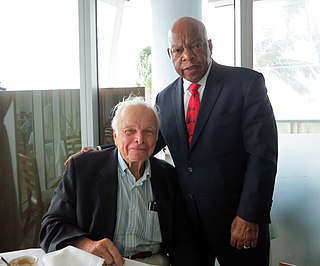
Robert Melvin "Bob" Adelman was an American photographer known for his images of the civil rights movement.

America in the King Years is a three-volume history of Martin Luther King Jr. and the Civil Rights Movement by Taylor Branch, which he wrote between 1982 and 2006. The three individual volumes have won a variety of awards, including the 1989 Pulitzer Prize for History.
James H. Karales was an American photographer and photo-essayist best known for his work with Look magazine from 1960 to 1971. At Look he covered the Civil Rights Movement throughout its duration, taking many of the movements memorable photographs, including those of the formation of the Student Nonviolent Coordinating Committee (SNCC) and of Dr. Martin Luther King Jr. and his family. Karales's single best known image is the iconic photograph of the Selma to Montgomery march showing people proudly marching along the highway under a cloudy turbulent sky.

The National Voting Rights Museum and Institute, established in 1991 and opened in 1993, is an American museum in Selma, Alabama, which honors, chronicles, collects, archives, and displays the artifacts and testimony of the activists who participated in the events leading up to and including the 1965 Selma to Montgomery marches, and passage of the 1965 Voting Rights Act, as well as those who worked for the African-American Voting Rights and Women's Suffrage movements. As the museum describes in its mission statement, it recognizes other people, events, and actions which furthered America's Right to Vote since "the Founding Fathers first planted the seeds of democracy in 1776." The museum was founded by Faya Ora Rose Touré and Marie Foster.
The history of the 1954 to 1968 American civil rights movement has been depicted and documented in film, song, theater, television, and the visual arts. These presentations add to and maintain cultural awareness and understanding of the goals, tactics, and accomplishments of the people who organized and participated in this nonviolent movement.
James M. Letherer, born and died in Saginaw, Michigan, better known as Jim Letherer, was an American civil rights activist. He walked on crutches the entire 54 miles of the 1965 Selma to Montgomery march for voting rights, and in 1966 walked with Martin Luther King Jr. in James Meredith's Mississippi March Against Fear. Letherer lost his right leg to cancer when he was ten years old. Letherer has received honors by the Selma to Montgomery Interpretive Center Museum in Alabama, which hosts a life-size statue of him.
With a big heart and a tenacious spirit, he trooped with King and fellow marchers in many a Deep South protest despite not having his right leg from birth. During the 1965 Selma to Montgomery march, Letherer – who used crutches – helped keep spirits high by unswervingly shouting out cadence for his remaining leg, by chanting, "Left, left, left!"
This is a timeline of the civil rights movement in the United States, a nonviolent mid-20th century freedom movement to gain legal equality and the enforcement of constitutional rights for people of color. The goals of the movement included securing equal protection under the law, ending legally institutionalized racial discrimination, and gaining equal access to public facilities, education reform, fair housing, and the ability to vote.
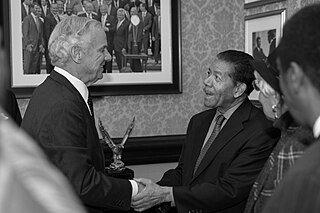
Cecil J. Williams is an American photographer, publisher, author and inventor whose photographs document the civil rights movement in South Carolina beginning in the 1950s.
Robert Houston was an American photographer born in East Baltimore. He documented the civil rights movement in the U.S., including Martin Luther King Jr.'s Poor People's Campaign and Resurrection City in Washington, D.C.
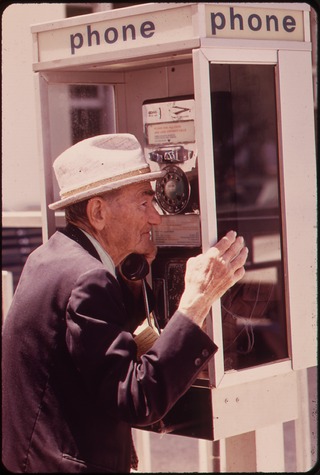
Flip Schulke was an American photographer.
James H. Peppler is a former newspaper photographer for The Southern Courier during the Civil Rights Era and then Newsday in Long Island, New York. He captured images of the Civil Rights Era in central Alabama. He later worked in New York City and taught photojournalism.
